The cruiser "Varyag". Fight Chemulpo 27 January 1904 of the Year. CH 20. Under the canopy of Sakura
It should be noted that the Japanese started the ship-raising operations immediately - January 27 (February 9 according to the new style) 1904 was fought, and on January 30 (February 12) the Maritime Minister ordered to form the naval expedition headquarters in Incheon, who led Rear Admiral Arai Yukan. After just 5 days, February 4 (February 17), headquarters specialists arrived at Asanman Bay, and the next day they began work.
However, the Japanese immediately faced serious problems. The cruiser lay down on the port side and was considerably submerged in the bottom silt (although the opinion of V. Kataev that the cruiser was sitting in it almost along the diametrical plane looks like an exaggeration). Before you raise the ship, it should straighten (put on an even keel), and it was a difficult task, requiring the maximum unloading of the cruiser.
Therefore, the Japanese began by making holes in the right side of the Varyag, in the area of coal pits through which coal and other cargoes were unloaded. The work was greatly complicated by both cold weather and the fact that the ship completely went under water at high tide. Since April 1904, the Japanese began to remove the artillery of the cruiser, and in June of the same year they began to dismantle the superstructures, chimneys, fans and other superstructures of the cruiser.
In mid-July, these preparatory works entered a stage at which one could already begin to straighten the hull. Pumps, whose task was to wash the sand from under the ship, were brought to Varyag so that it fell into the formed pit with a decrease in roll. This led to partial success - the bank slowly straightened, although there is a discrepancy in the sources. R.M. Melnikov wrote that the roll decreased by 25 hail. (that is, from 90 degrees to 65 degrees), but V. Kataev claims that the list has reached 25 degrees, and, judging by the photos, all the same V. Kataev is right. Be that as it may, the left side of the cruiser was gradually freed from silt, and the Japanese were able to cut off those structures and remove the artillery that had previously been sunk into the silt and was not available to them.
In early August, the Japanese considered that they had done enough to enable Varyag to be raised. Having sealed the ship, as far as they could, and delivering pumps with a total capacity of 7 000 t / h to it, the Japanese attempted to lift, simultaneously pumping out water and pumping air into the cruiser's premises. It did not succeed, and then by mid-August additional pumps were delivered, so their total performance reached the 9 000 t / hour. But this did not help either. It became clear that a caisson was needed, but there was almost no time left for its construction, as the cold weather came. Nevertheless, they tried to build hastily - but the third attempt with an improvised caisson also failed. It was obvious to everyone that in 1904 the cruiser could not be raised in any way, so the 17 (30) of October, having previously fixed the cruiser on the ground with ropes, the Japanese interrupted the rescue work left Varyag “until better times”.
In the following, 1905, the Japanese engineers decided to approach the matter much more thoroughly than the previous one. They started the construction of a grand caisson - the total displacement of it and the ship, according to V. Kataev, was to reach 9 000 t. Moreover, its height (as if continuing the sides of the ship) was to be 6,1 m.
The construction of this very monstrous construction was started at the end of March (9 April) 1905. After the wall on the starboard of the cruiser was completed, the rectification of the ship was resumed. Gradually, things went smoothly - by the beginning of July, the cruiser managed to straighten the 3 to a roll in degrees, that is, to practically put on an even keel, but it still remained on the ground, but after that, for the 40 days they completed the left side of the caisson and did other work . Since it was considered that the existing pumps were not enough, 3 powerful pumps were also reordered, and now they have been delivered to the cruiser.
And finally, after a long preparation, on July 28 (August 8) the cruiser finally surfaced, but, of course, work on its restoration was just beginning at that point.
The repair of the case continued, in order to ensure watertightness, but the caisson was disassembled for uselessness. After the survey, Yukan Arai suggested not to tow the “Varyag”, but to ensure his transfer under his own cars - the proposal was accepted, and work began to boil on the ship. They cleaned and rebuilt the boilers, put the equipment in order, put temporary pipes (instead of the cut ones during the ascent).
The 23 of August (5 of September) ended the Russo-Japanese War - the cruiser, although it was raised, but still remained in the water area of Chemulpo. For the first time after its flooding, Varyag launched 15 (28) in October, developed 10 nodes, steering, cars and boilers operated normally. October 20 (November 2) A Japanese naval flag was hoisted over the Varyag on 1905 and after a day's 3 went to Japan. The cruiser was supposed to go to Yokosuka, but on the way he had to go to Sasebo, where he had to be put in the dock, as water entered the ship’s hull. As a result, the cruiser arrived in Yokosuka 17 (30) November 1905.
Here the ship was waiting for a refurbishment, which lasted exactly two years: the cruiser went out to the factory and then to the sea trials in November 1907 g. As a result, with the power 17 126 hp and the 155 revs the cruiser reached 22,71 knots.
According to the results of tests on November 8 (21), 1907, the "Varangian" (under the name "Soya") was accepted into the Japanese Imperial fleet like a class 2 cruiser. After 9 months, on August 15 (28), 1908, Soyu was transferred to the Training Squadron of the Naval School in Yokosuka as a training vessel, which he served as until March 22 (April 4), 1916, when the cruiser, after moving to Vladivostok, lowered the Japanese flag and returned to the ownership of the Russian Empire. It must be said that the cruiser was operated very intensively as a training ship: in 1908, it participated in large fleet maneuvers, in 1909 and 1910. went on long sea trips with cadets on board. This was followed by an almost eight-month overhaul (from April 4 (17), 1910 to February 25 (March 10), 1911), followed by the period 1911-1913. “Soya” makes two more four-month training trips in the Pacific Ocean, but on November 18 (December 1) 1913 it was withdrawn from the Training Squadron and, a day later, it again undergoes a major overhaul, which lasted almost exactly a year - the cruiser returns to the Training Squadron also November 18 (December 1), but already in 1914. In 1915, the cruiser makes its last training trip under the Japanese flag, and in early 1916 the procedure for transferring it to Russia follows.
It seems to be a solid routine, and nothing interesting - but many revisionists use the fact of service in the Japanese navy as evidence that domestic claims to the Varyag power plant are contrived. At the same time, there are two “revisionist” points of view: that in fact the power plant of the Russian ship was in perfect order, or (second option) it did have problems, but only because of the “curvature” of domestic operators, but in the skillful Japanese hands the cruiser served perfectly.
Let's try to understand all this impartially.
The first thing that people usually pay attention to are those 22,71 speed nodes that Soy has managed to develop in tests. But this is not at all surprising: examining in detail the misadventures of the Varyag power plant, we came to the conclusion that the main problem of the ship was steam engines that were adjusted (more precisely, misaligned) so that they could only work effectively and without fail high pressure of steam, which was simply dangerous to give by the boilers of the Nikloss system, why a vicious circle was obtained - or to give high pressure, risking the life of the firemen, or to put up with the fact that the cars were gradually spread with E itself. At the same time, the author of this article (after engineer Gippius) believes that a similar situation arose due to the firm of Charles Crump, who “optimized” the machines only to achieve the high speeds required to fulfill the conditions of the contract. But in the comments, another idea was repeatedly expressed that the main damage to the power plant was caused in the initial period of the ship’s operation, when its crew tried to solve the problems with half measures, which were possible on the ship, far from shipyards, but which were not at all eliminated the true causes of malfunctions, struggled with the consequences, and not with the causes, and this did not really help, leading only to the fact that things were getting worse and worse with the car. Regardless of who was right, all of this led to the fact that in Port Arthur cruiser’s cars came to such a state that they could only be rehabilitated by an overhaul at a specialized enterprise, which in the Far East could not be taken from. Well, without professional “capital”, and with those scanty production capabilities that our compatriots in Port Arthur had, “Varyag” somehow issued 17 nodes for testing after the last repair, but when trying to raise the speed, bearings began to knock.
However, the Japanese during the two-year restoration work after the rise of the “Varyag”, naturally, did everything necessary. The cruiser cars were dismantled and studied, many parts and mechanisms (including bearings in high and medium pressure cylinders) were replaced. That is, "Soy" received the repair, which he needed, but which was not got to "Varyag" - it is not surprising that after this the ship could give about 23 speed nodes. And of course, the test results of November 1907 can in no way indicate that the Varyag could have developed similar speeds in Port Arthur or during the battle at Chemulpo.
But the further exploitation of the cruiser ... to put it mildly, raises a lot of questions that, apparently, the "revisionists" absolutely do not come to mind. Let's take a look at what happened in the Japanese Imperial Navy at the time when "Soy" was in its composition, that is, in the interval between the Russian-Japanese and the First World Wars.
I must say that during the Russo-Japanese War, the Japanese armored cruisers proved themselves very well. Not that they won any major victories, but the services of numerous "volatile" detachments made up of these ships provided Admiral Kheykhatiro Togo with invaluable advantages in terms of reconnaissance and observation of the movements of Russian ships. Special troubles were delivered to the Russians by the so-called “dogs” - a detachment of high-speed armored cruisers, with which only the latest Russian “six thousand meters”, that is, “Askold”, “Bogatyr” and “Varyag”, could speed up. "Bayan" was slower, and "Boyar" and "Novik" are too weak to count on success in artillery fighting with "dogs." And, in fact, the same "Askold", although it was larger and stronger than any "dog" (if you do not take into account the quality of the shells, of course), but its advantage in artillery was not so great as to guarantee victory - but the pair "Dogs" he was already seriously inferior.
But X. Togo had little dogs, only one combat unit, which necessitated the extensive use of weaker or outdated cruisers (often both at the same time), right down to the old ladies - “Itsukushim”. The fighting qualities of such ships, of course, did not give them any special chances of success in a collision with a comparable number of Russian cruisers, and their speed was too small to escape. Accordingly, to give such detachments combat stability, the Japanese were forced to use armored cruisers, and this was not always a good decision. So, for example, H. Togo in the squadron battle at Shantung was able to put in line only two armored cruisers of the four available, and another managed to join in the second phase of the battle. “Dogs” in this regard was easier, because they (at least theoretically) had enough progress to avoid undue “attention” of Russian cruisers. However, the Japanese also preferred to support their actions with heavier ships.
In general, it can be stated that the armored cruisers of Japan became the "eyes and ears" of the United Fleet during the Russo-Japanese War, and their multiplicity played a large role in this. However, after the war, the capabilities of this class of ships began to rapidly decline.
The combined fleet entered the war, having 15 armored cruisers. But of the four dogs, only Kasagi and Chitose survived the war: Yosino sank, rammed by Kasuga, and Takasago went to the bottom the day after the bombing of a Russian mine. As for the rest of the 11, a significant part of them was very outdated, part of the unsuccessful construction and by 1907, when the Soybean was commissioned, many of these ships lost their combat significance. In fact, perhaps only two cruisers of the “Tsushima” type and only the “Otova” that became operational during the war retained some combat value.
In 1908, the Japanese fleet core, previously comprised of 6 squadron battleships and 8 armored cruisers, increased significantly. In exchange for the lost Yasima and Hatsuse, they received quite modern Hijen and Iwami (Retvisan and Orel, respectively) and two new British-built battleships, Kashima and Katori. The victim was in the explosion of "Mikasa" was also repaired and introduced into the fleet, and much more powerful "Satsuma" and "Aki" were built at the Japanese shipyards with might and main. Of course, the Japanese also got other Russian battleships, but almost immediately after the repairs, they were counted as ships of coastal defense. As for the armored cruisers, none of them died in the Russian-Japanese, and after it the Japanese introduced the repaired Russian "Bayan" into the fleet and themselves built two Tsukuba-type cruisers. Thus, in the Russo-Japanese war at the peak of power, the Japanese had a fleet consisting of 6 armadillos and 8 armored cruisers with 15 armored. In 1908, the United Fleet had 8 armadillos and 11 armored cruisers, but only 5 armored cruisers, of which only two were fast, could provide them with intelligence. All this forced the Japanese to retain in the fleet both frankly unsuccessful ships of the Akashi type, and older cruisers (before World War I “lived on” in one form or another, the Akashi, Suma, and five older cruisers). As for the Russian trophies, besides the “Soy”, the Japanese “got hold of” only the “Tsugar” - that is, the former Russian “Pallada”, which in its tactical and technical characteristics, of course, could not be considered a full-fledged reconnaissance cruiser, Yes, and introduced it to the fleet only in 1910, almost immediately retraining in the training ship. But Japan hardly built or ordered new armored cruisers - in fact, in 1908 there was only “Tone” in the building, which was put into operation only in 1910.
Thus, in 1908, the United Fleet is beginning to experience an obvious shortage of reconnaissance cruisers under major forces. Here, in theory, the “Soya” just taken into the fleet should have come in handy - fast and well-armed, it was quite capable of complementing the “Kasagi” and the “Chetose” with a third ship: its presence made it possible to form a full-fledged fighting squad of three ships with sufficiently similar performance characteristics.
But instead, the just-completed repair cruiser is sent ... to training ships.
Why is that?
Perhaps the Japanese were not satisfied with the speed of the "Soy"? This could not be, because the "passport" (achieved on the tests of 1907 g) cruiser speed almost corresponded to the speed of the most high-speed Japanese "Chitose" and "Kasagi", and in 1907, at the time of their tests, most likely, " Soy ”outperformed any Japanese cruiser.
Armament? But a dozen six-inch guns that were on the Soi were fully in line with, and perhaps even surpassed, in firepower, 2 * 203-mm and 10 * 120-mm guns that carried doggies, and they had the strongest armament among the Japanese armored cruisers. In addition, the cruiser was easy to rearm under Japanese standards.
Perhaps, “Varyag” somehow did not fit into the new tactical doctrines of the Japanese fleet? And this question should be answered in the negative. If we look at the “Tone”, which was just being built at this time, then we will see a ship, somewhat smaller than “Soy”, of dimensions (full displacement of 4 900), with a maximum speed of the 23 node and armament as part of 2 * 152 -mm and 10 * 120-mm. There was no armor belt, the deck had the same thickness as the “Soi” - 76-38 mm. At the same time, in the case of the “Tone”, the Japanese almost immediately turned their attention to the cruiser’s seaworthiness — well, and soybeans were distinguished by good seaworthiness, surpassing the old Japanese cruisers! In other words, the Japanese built a cruiser for their fleet, whose capabilities were extremely similar to those possessed by Soy, so it’s impossible to talk about any tactical unsuitability of the former Russian ship.
What else is left? Perhaps the Japanese were prejudiced against Russian-built ships? This is clearly not the case - the squadron battleship "Eagle" for a long time remained in the composition of the Japanese fleet. And in general, “Soyu” was built not by the Russians, but by Kramp, while “Kasagi” went to the United Fleet - the child of the shipyards of the same shipbuilder.
Perhaps, the Japanese experienced some hatred for the boilers of Nikloss? Again, no, if only because the former Retvizan, which had boilers of the same design, not only participated in the military operations of the First World War, but later remained in the line forces of the Japanese fleet right up to 1921.
What else have we not mentioned? Oh yes, of course - perhaps due to the expansion of the fleet, Japan was in dire need of training ships? Alas, this version also does not withstand any criticism, because the United Fleet received a huge number of ships of dubious combat value, sailing under the flag of St. Andrew. The composition of the Japanese fleet included “battleships-cruisers” “Peresvet” and “Victory”, “Poltava” and “Emperor Nicholas I”, two coast-guard battleships, “Pallada”, finally ...
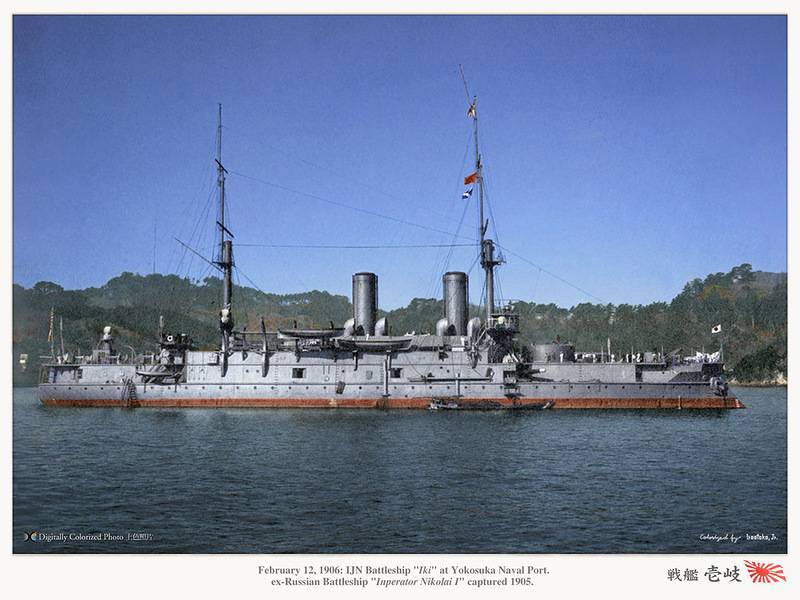
All these ships were introduced by the Japanese into service either initially as training or as coastal defense ships, which practically did not differ from the training one. And this is not counting, of course, many Japanese armored cruisers, which have practically lost their combat significance. In other words, the Japanese had enough training ships (and, as it were, not in abundance) to have the need to withdraw for these purposes one of the most well-armed, high-speed and seagoing reconnaissance cruisers, which seemingly was the Soya in 1908.
Perhaps, dear readers will be able to come up with some other reasons, but the author of this article no longer has them. And the most likely version of the "deduction" of "Soi" in the training ships looks like ... continuing problems with the power plant, which, according to the author, continued to pursue the cruiser after the repair of 1905-1907.
In support of this hypothesis, the condition of the boilers and Soi machines, more precisely, the Varyag again after the cruiser was transferred to the Russian Empire, can be given: as we have said, it happened in 1916 4 g in Japan in February A commission arrived to receive ships (along with the Varyag, the battleships Poltava and Peresvet were bought out. Her conclusion on the power plant was rather negative. The cruisers' boilers, according to the commission, could have lasted a year or two more from the year, and the rivets in four boilers were found to have eroded, as well as tube bending and cracks in the collectors of several other boilers (alas, the exact number of damaged boilers is unknown to the author). Also noted "some sagging propeller shafts."
The transfer procedure was pretty crumpled, the Russians simply were not allowed to dig into the ships properly. But when they arrived in Vladivostok and they were taken seriously, it turned out that almost all cruiser systems, including the power plant, required repairs. The valves of the boilers, machines and refrigerators were again removed, pipes and manifolds of the boilers were put in order, machine cylinders were opened, etc. etc., and this seemed to give the result - on the tests of 3 (15) in May, using the 22 boiler from 30, Varyag developed 16 nodes. But already at the third time out at sea, held on 29 in May (11 June) 1916, the ship had to be given a “stop machine” - the bearings started to clatter again ... Interestingly, the cruiser did not even try to test the full speed - even a cursory inspection of the commission that accepted Varyag ”, revealed that in the current state of speed, close to the contract, the ship is unattainable.
And everything would be fine, but in such a state the cruiser turned out to be only a year and four months after passing the one-year overhaul of the Japanese! At the same time, as we said above, they didn’t "drive him into the tail and into the mane" - the ship made only one four-month training trip in the past year and 4.
Therefore, the author’s version is that the Japanese, after two years of repair of the Varyag in 1905-1907, introduced it into the fleet, but still could not ensure stable operation of the power plant — the cruiser showed its 22,71 ties during tests, but then again went racing. And if the real speed of the "Soybean" was not too different from that of the "Varyag" (that is, about 17 nodes without the risk of breaking the machine or someone to cook alive), then, of course, such a ship was not a valuable asset for the United Fleet , so that he was quickly "put off" in training.
Attention is drawn to the fact that Japan, generally speaking, "yielded" to the Russian empire ships on the principle of "Upon you, God, that we are not worthy." And the fact that they agreed to sell us "Varyag", without trying to concede, it seems to be inferior to "Pallas" in all respects, speaks volumes. Although it is possible that in fact there were such attempts, it’s just that the author of this article does not know about them.
Interestingly, later, after the return of the cruiser to Russia, assessing the condition of the cruiser before sending it for repair to England, it was considered possible, based on the results of this repair, to ensure the ship to go for several years at a speed of 20 nodes without the risk of breakdowns.
Thus, we can state that those 22,71 nodes developed by Varyag after two years of 1905-1907 repair do not at all indicate that he was able to develop the same, or at least comparable, speed during Chemulpo. In addition, there is no evidence that the Varyag retained the ability to develop such speed for some time while serving in the Japanese fleet, and indirect signs indicate that this cruiser had problems with the power plant and under the shadow of the Mikado flag . And all this allows us to assume that the main culprit in the troubles of this cruiser was, after all, his designer and builder C. Crump.
This article we finish the description stories cruiser "Varyag" - we only need to summarize all the assumptions that we made during the cycle dedicated to him, and to draw conclusions what the last, final article will be devoted to.
The ending should ...
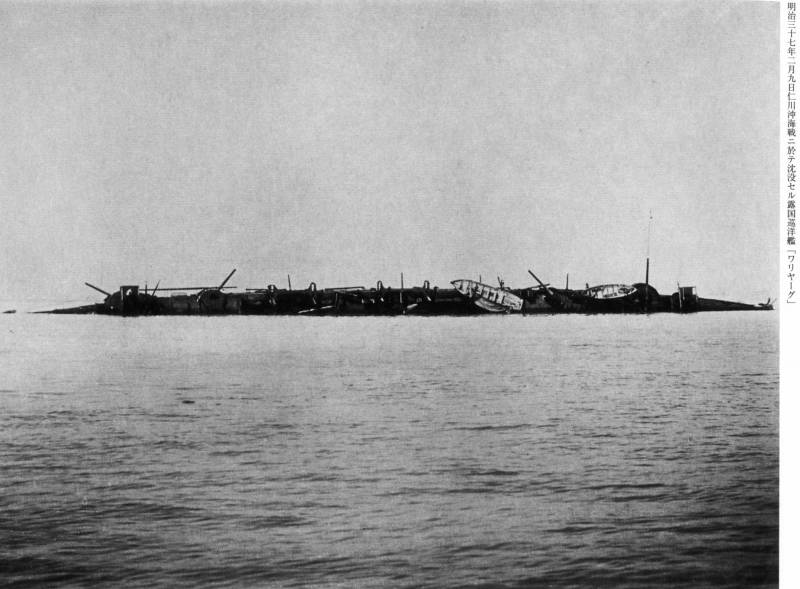
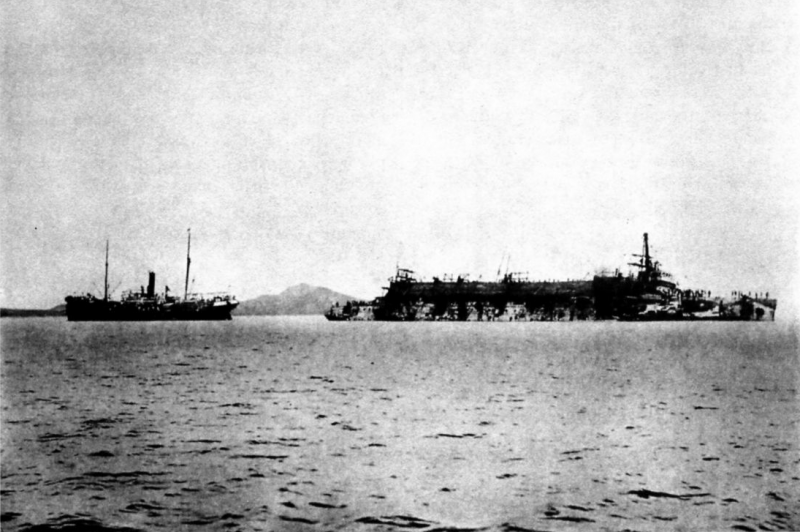
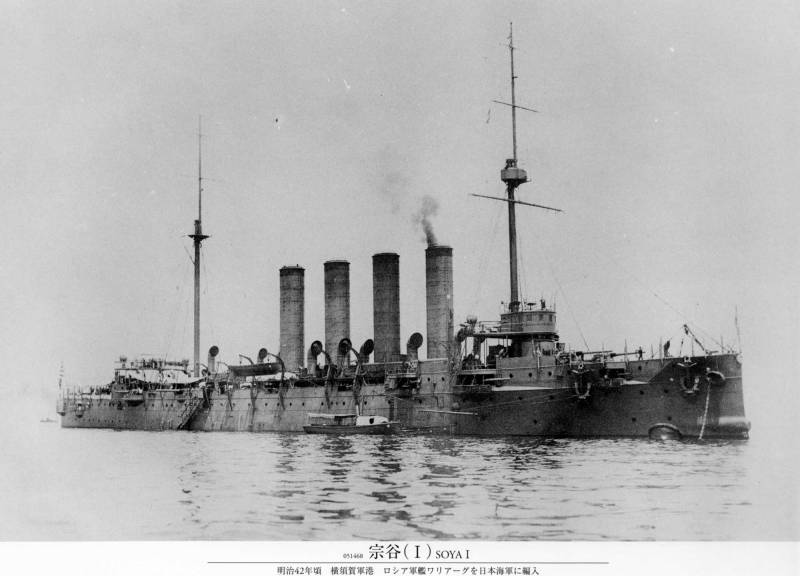
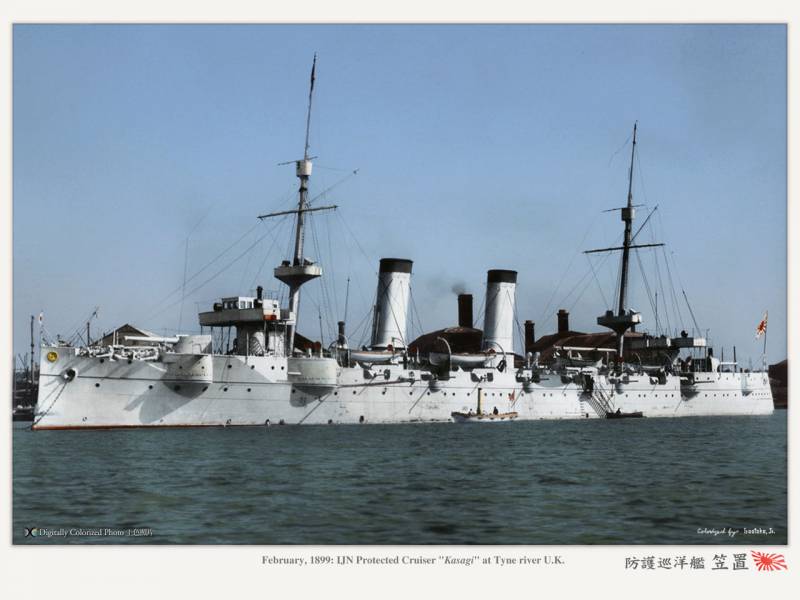
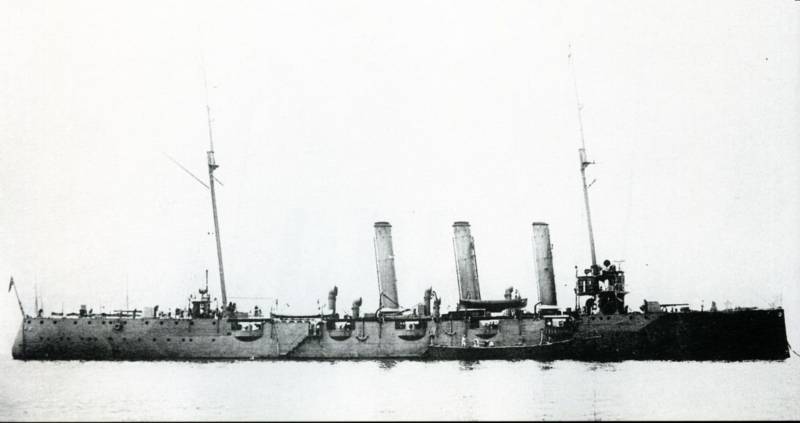
Information